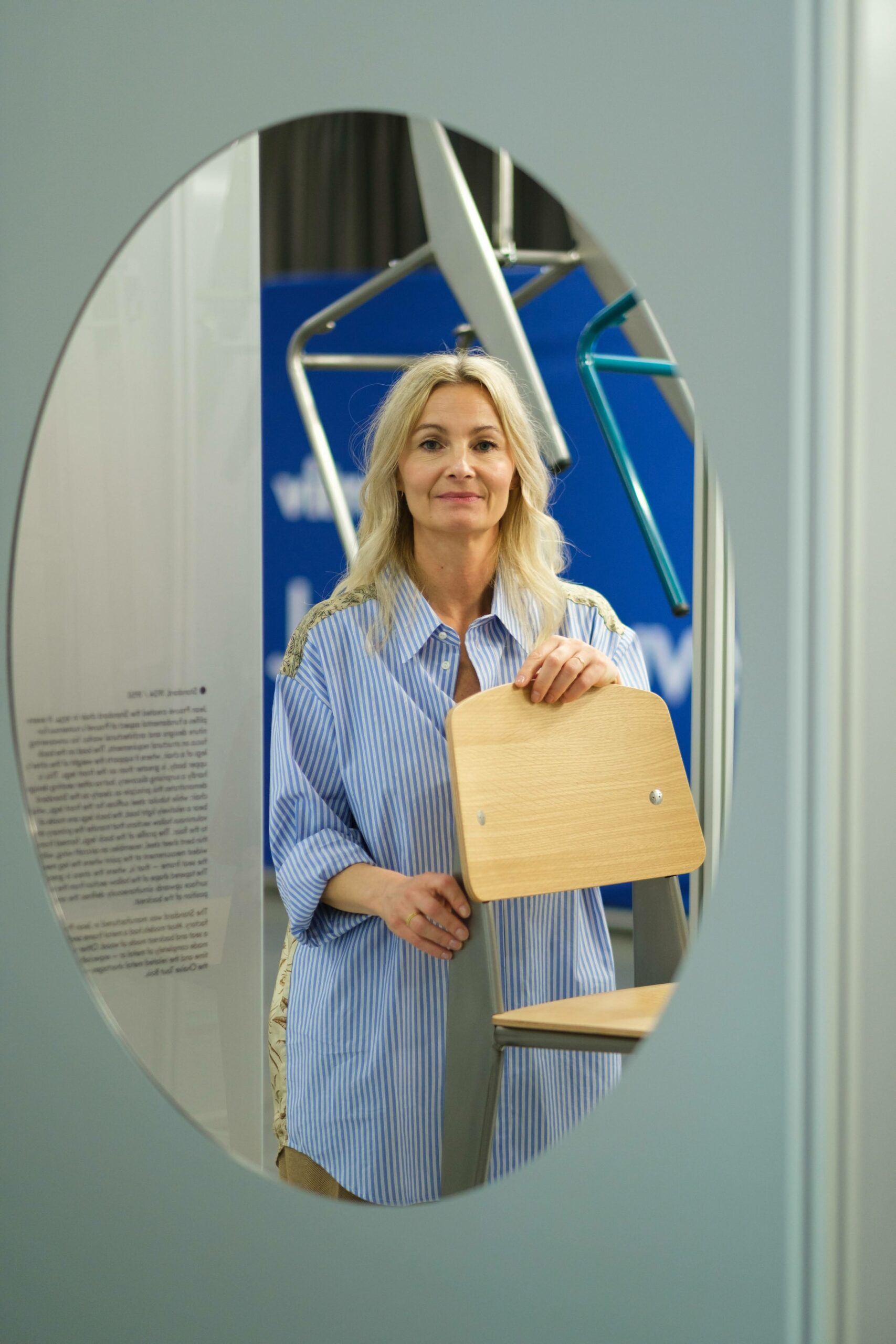On simplicity, luxury and the influence of biographical context on creative people
Reporter: Cătălina Frâncu
Photo: Project1
INTRO
Stine Liv Buur, architect and design manager of all the creations featured in Vitra’s Classics and Originals collections, spoke to us about the life and work of Jean Prouvé during the Vitra Prouvé Roadshow exhibition held at the Universul Palace in conjunction with Romanian Design Week. We discussed what design means in the spirit of Jean Prouvé and the artistic contexts that give birth to such creative minds, and also talked about the topics of luxury and craftship.
Jean Prouvé had the rare quality possessed by architects who come to the profession from another field: his experience as a blacksmith allowed him to handle the entire development process from raw material to the finished product, following his internal logic with the confidence of someone who could build on his former accomplishments and expertise. In design, the azimuth perspective is indispensable for a project because it alone has the power to maintain a direction – during the building phase, things change, calculations are modified; once the project leaves the paper, negotiations begin: with people, with materials, with spaces and functions – the project is just the contractual framework. Jean Prouvé had the ability to put aside the plans and pick up tools himself; that’s where his initiatives started. After trying his hand at Art Deco projects with decorative objects, he progressively abandoned ornamentation and experimented with bending metal. The possibility of standardisation stimulated his imagination: on the one hand, the potential of mass production opened up the horizons of experimentation with furniture, and on the other, it prompted the following question: ‘How should a house be designed so that it can be assembled in less than 7 hours by a few people with basic tools?’ The answer was the ‘Maison des Jours Meilleures’, designed at the request of Abbé Pierre as a shelter for the homeless in the winter of 1954.
Prouvé responded to the need for efficiency in the first half of the century and contributed both intentionally and circumstantially to the contemporary image of quality objects: ergonomic, efficient and with a clear structural design. His solutions tackled the problem of housing both for the homeless and for French settlers in West Africa (Maison Tropicale) – the defining characteristic of his work was the transportability of his creations, whether they were houses or chairs.
Interview
How would you describe the design process in continuation of Jean Prouvé’s legacy?
It is intense – when dealing with the Prouvé portfolio at Vitra, we regularly ask ourselves ‘What would Jean Prouvé do?’ We have been working with both his daughter and granddaughter, Catherine Prouvé and Delphine Drouin-Prouvé, for some time now. Another very important source of inspiration is the extensive Prouvé Collection at the Vitra Design Museum in Weil am Rhein, Germany: here we can find many answers to the questions we need to ask in the design process.
How do you choose the direction? At what point in the process do you know you’re on the right track?
In order to promote not only the aesthetic but also the intrinsic coherence of Jean Prouvé’s oeuvre, Vitra is constantly monitoring societal shifts and emerging needs at work, in the home or in public spaces. After such analysis we develop a direction in response to our findings. When it comes to design, we carefully and repeatedly test colours, surfaces and materials before we prototype in order to make sure every detail is aligned with Jean Prouvé’s thinking. Last but not least, the family is involved in all stages of design.
How do you think being a craftsperson influenced Jean Prouvé’s architecture?
Jean Prouvé was a blacksmith. He was part of an artistic family and had both scholastic and applied input, so he experimented with abstractions as well as with pure craftship. He chose to work with metal sheets using pressing and bending machines and avoided bars or other prefabricated metal objects. Working directly with the material, his techniques respected both its inherent limits and opportunities, which he explored further in his architecture (Maison Tropicale, Maison des Jours Meilleurs) where he concentrated on transportability, modularity and ease of construction with simple tools.
One of the colours in the chair palette is inspired by the grey walls of Vermeer’s The Milkmaid. Do you often look to art when devising colour palettes for new objects? What do you look for specifically?
Jean Prouvé indeed drew inspiration for the shade Gris Vermeer (Vermeer Grey) from Vermeer’s painting The Milkmaid – but he didn’t stop there: he also designed a series of other colours that have not yet made it to the Vitra portfolio. We will most certainly bring them to life in future projects.
What do you think the connection is between ‘learning from the masters’ and innovation? Given that Prouvé grew up in an artist’s house and had early contact with creative people, to what extent was he inspired and destined to follow a certain path?
The craftsperson and architect Jean Prouvé grew up in a creative family: his father, Victor Prouvé, was a famous French painter and his mother, Marie Duhamel, a talented pianist. His godfather was the artist and designer Emile Gallé who is considered one of the major innovators of French Art Nouveau. This environment was a fertile ground for Jean Prouvé, allowing him to explore the different arts and crafts he was surrounded by. Training as a blacksmith with an already artistically rich background proved to be the foundation of his innovation: he was equipped with enough know-how at an early age to use it creatively to solve problems, he had sufficient cultural knowledge to be able to make informed and timely decisions and was determined to combine his skills with those of other creators – in his words: ‘Innovation is a group affair… In life you do nothing alone. Work is a collective venture.’
Prouvé was a practical man and his work is timeless. His simple lines and direct answers to specific needs produced items such as the Standard chair, but also the Maison Tropicale. What would you say makes this practical approach so luxurious today? Is it the techniques he used, or his biography as a whole, or is it something else?
Jean Prouvé’s approach is so pertinent today for a number of reasons: first, his use of metal and wood make his designs less wasteful and more akin to contemporary discourses on slow design. Second, their simplicity keeps them relevant for any interior today – while lending their defining aesthetic and appeal to a space, they also reflect the identity of their surroundings, blending into a coherent design. Third, our contemporary notion of luxury is shifting, although the number of different approaches to luxury make it hard to pinpoint any single direction. Jean Prouvé’s designs are invested from the beginning with tranquillity, calm and order and his creations are objects that ensure optimal function and surpass any given definition of luxury, transcending status and directly addressing human needs. No matter where his designs are used, be it at work, in a restaurant, at home or in a hotel, Prouvé’s furniture generates the same sense of quiet serenity. And finally, his craftship is visible throughout his oeuvre, resulting in creations that are robust, yet simultaneously light and elegant.



